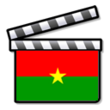Cinema of Burkina Faso
| Cinema of Burkina Faso | |
|---|---|
| No. of screens | 10 (2009)[1] |
| • Per capita | 0.1 per 100,000 (2009)[1] |
| Produced feature films (2009)[2] | |
| Fictional | 4 |
| Animated | - |
| Documentary | - |
| Cinema of Burkina Faso |
|---|
 |
|
List of Burkinabé films |
|
Panafrican Film and Television Festival of Ouagadougou |
The cinema of Burkina Faso is one of the more significant in Africa,[3] with a history that spans several decades and includes the production of many award-winning films.
History
The cinema of
Today's cinema
In the late 1990s, local private production companies began to proliferate and digital production became increasingly prevalent. By 2002 over twenty-five small production companies existed in the country, many pooling their resources and expertise in order to produce. The best known directors from Burkina Faso are:
Burkina also produces popular television series such as Bobodjiouf. The internationally known filmmakers such as Ouedraogo, Kabore, Yameogo, and Kouyate make also popular television series.Distribution

Many films shot in Burkina Faso by local directors have found distribution in
Festivals and schools
Burkina Faso hosts the Panafrican Film and Television Festival of Ouagadougou (FESPACO) every two years in Ouagadougou, Burkina Faso's capital.
In 2005, director Gaston Kaboré, who won the top prize at FESPACO in 1997 for his film Buud Yam, opened a training school for new filmmakers in Ouagadougou. The school, named Imagine, was built with millions of CFA of Kaboré's own money and opened its doors for the Panafrican Film and Television Festival of Ouagadougou 2005.
Major feature films
- Idrissa Ouedraogo.
- Tilaï (1990), directed by Idrissa Ouedraogo.
- S. Pierre Yameogo
- Buud Yam (1997), directed by Gaston Kaboré.
- Kini and Adams (1997), directed by Idrissa Ouedraogo.
- Garba (1998), directed by Adama Roamba.
- Silmande Tourbillon (1998), directed by S. Pierre Yaméogo.
- Fanta Regina Nacro.
- Delwende ("get up and walk") (2005), directed by S. Pierre Yameogo.
See also
- Cinema of the world
- Cinema of Africa
- Cinema of Senegal
- Cinema of the Democratic Republic of the Congo
- World cinema
References
Notes
- ^ a b "Table 8: Cinema Infrastructure - Capacity". UNESCO Institute for Statistics. Archived from the original on 24 December 2018. Retrieved 5 November 2013.
- ^ "Table 1: Feature Film Production - Genre/Method of Shooting". UNESCO Institute for Statistics. Archived from the original on 5 November 2013. Retrieved 5 November 2013.
- ^ Spaas, p. 232
- ^ Spaas, pp. 232-246
- ^ Turégano, Teresa Hoefert, African Cinema and Europe: Close-Up on Burkina Faso, Florence: European Press Academic, 2005.
Sources
- Mahir Şaul and Ralph Austen, eds. Viewing African Cinema in the Twenty-First Century: Art Films and the Nollywood Video Revolution, Ohio University Press, 2010, ISBN 978-0-8214-1931-1
- Spaas, Lieve (2001). The Francophone Film: A Struggle for Identity. ISBN 0-7190-5861-9.
External links
- Burkinabé film Archived 2009-02-18 at the Internet Movie Database

